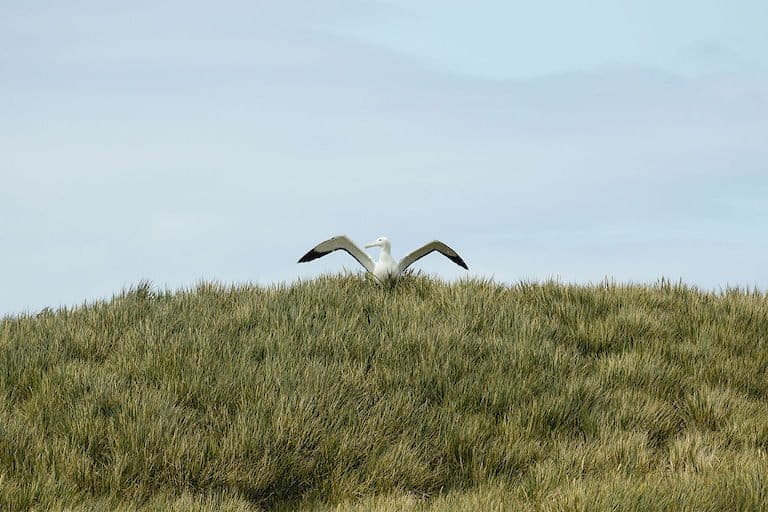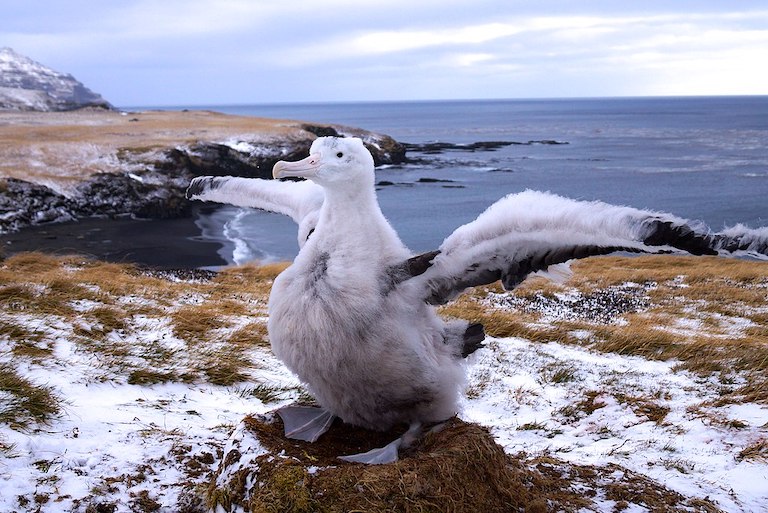- Albatrosses fitted with tiny radar-detecting trackers can help spot fishing vessels that have gone “dark” by turning off their AIS onboard tracking systems, a new study has found.
- Over a six-month period, 169 wandering and Amsterdam albatrosses fitted with GPS trackers covered more than 47 million square kilometers in the southern Indian Ocean, detecting radar signals from 353 different boats in the process.
- In international waters, 37% of the boats had no AIS signal, a clue they could be engaged in illegal activity; within countries’ exclusive economic zones, nearly 26% of the boats were without an AIS signal.
- The findings suggest the seabirds could be deployed to patrol the ocean for vessels operating illegally, complementing a growing body of detection methods.
There are plenty of ways to hide in the open ocean if you want to fish unnoticed. Many fishing boats do just that. They turn off their public tracking systems to mask their activities in locations they’re not supposed to be in, such as within marine protected areas or in the waters of a country they aren’t authorized to enter.
Listen to the article here:
But researchers have come up with a new way of surveilling these ships: recruiting large albatrosses. Fitted with tiny radar-detecting trackers, the birds can help spot fishing vessels that have gone “dark” by switching off their onboard automatic identification system (AIS). In a six-month pilot study, the birds detected illegal or undeclared boats within both national exclusive economic zones (EEZs) and international waters, across a vast area of the ocean, the researchers report in a new study published in the Proceedings of the National Academy of Sciences.
“There is wonderful elegance in using birds to monitor fishing vessels, largely because these vessels threaten some bird populations,” David Kroodsma, director of research for the online vessel tracking platform Global Fishing Watch, who was not involved in the study, told Mongabay. “It is great to see teamwork with nature.”

All ships weighing 300 gross tons or more are required to carry an AIS, which transmits details via satellite about the ship’s identity, location, direction and speed to stations on the shore, other ships, and aircraft. But AIS signals can go missing. This could be unintentional, as when a ship passes through a region with weak satellite reception. Or a boat’s crew may intentionally turn its AIS system off to conceal its tracks.
Most vessel crews leave their marine radars on, though. Radar signals help them detect other ships, maneuver around obstacles, and avoid collisions. But these signals have a small range and are detectable only within a few miles, keeping the vessels largely “dark.”
Enter the albatrosses. These large seabirds are attracted to fishing boats, especially ones with bait and offal on offer. It’s this attraction that could make the birds good patrollers of the ocean, or ocean sentinels, the researchers speculated.
Henri Weimerskirch, a marine ornithologist at the National Center for Scientific Research (CNRS) in France, and his colleagues tested out their concept with wandering (Diomedea exulans) and Amsterdam (Diomedea amsterdamensis) albatrosses. Between November 2018 and May 2019, they taped small radar-detecting GPS loggers, which they had developed over three years, on the backs of 169 albatrosses from the islands of Crozet, Kerguelen, and Amsterdam in the southern Indian Ocean.

In a previous study, the team had shown that the GPS loggers can pick up radar signals from ships and transmit them to satellites whenever the birds are within five kilometers of the vessels. In the latest study, the team expanded this work to see if birds carrying these loggers could spot fishing vessels without detectable AIS signals. And the albatrosses did.
During the six-month period, the birds made multiple foraging trips to the sea, covering an area of more than 47 million square kilometers (18 million square miles) and detecting radar signals from 353 different boats in the process. About 100 of these boats had no AIS signal, suggesting they could be operating illegally. In international waters, 37% of the boats had no AIS signal; within countries’ EEZs, nearly 26% were without an AIS signal. None of the vessels operating around South Africa’s Prince Edward Islands, for example, had an associated AIS signal.
“Contrary to what we thought there is a large proportion of boats without AIS in EEZs and therefore a large proportion of illegal boats,” said Alexandre Corbeau, a doctoral student at CNRS and a co-author of the study. “Outside the EEZs we knew that there would be a higher proportion of undeclared vessels but this is the first time that we have a real estimate that shows the importance of undeclared fishing in the South Indian Ocean.”
How many of the fishing vessels without AIS in the study were operating illegally needs to be confirmed.
One constraint on deploying armadas of albatross spies is that the extent of the ocean the birds can patrol is limited by the area they forage and live in. How frequently the birds patrol the same area also remains to be seen.
“Each bird can only ‘see’ an area that is a few tens of kilometers across at any given moment, and the ocean is thousands of times larger than that, meaning the birds can only monitor a small part of the ocean at one given moment,” Kroodsma said. “I think that means that you will get lots of snapshots of where vessels are, but you might not track every vessel, and you likely can’t track many vessels over time.”
There are other technologies that can monitor the presence of dark ships. These include satellites equipped with optical sensors that can snap high-resolution images on low-cloud-cover days, or with synthetic-aperture radar (SAR) sensors that can see through clouds. But these, too, provide only snapshots and are limited to when the satellites are overhead and turned on, Kroodsma said.
The value of having a variety of technologies, he added, is the potential to combine them together to get a complete picture of what vessels are doing on the ocean.

The tagged albatrosses can also help pinpoint areas where the seabirds interact with fisheries. This is important, the researchers said, because 15 of the 22 albatross species are threatened, including the two used in the study, and hundreds of thousands of these birds are estimated to drown each year when they get caught on the baited hooks of fishing gear. The study found some patterns: only 10% of the birds did not encounter a fishing vessel while out foraging; adult albatrosses were more likely to fly closer to fishing vessels than younger birds; and wandering albatrosses approached fishing boats more frequently than Amsterdam albatrosses.
Could the use of loggers put the threatened albatrosses at greater risk? The researchers say that’s unlikely. The loggers weigh between 55 and 65 grams (1.9 and 2.3 ounces), less than 1% of the birds’ body weight. “This is much less than the recommended 3%,” Corbeau said.
The loggers are also difficult to spot with the naked eye because they’re attached on the birds’ backs with plumage-colored tape, he added. So fishers would have a hard time identifying tagged birds.
“The beacons transmit the information 5 kilometers [3 miles] from the boat, so long before the birds are visible from the boat,” he said. “It should also be noted that hundreds of birds are permanently behind the boats and therefore locating an albatross equipped is very difficult.”

Shreya Dasgupta is an independent science writer based in Bangalore, India. Follow her on Twitter @ShreyaDasgupta.
Citation:
Weimerskirch, H., Collet, J., Corbeau, A., Pajot, A., Hoarau, F., Marteau, C., … Patrick, S. C. (2020). Ocean sentinel albatrosses locate illegal vessels and provide the first estimate of the extent of nondeclared fishing. Proceedings of the National Academy of Sciences, 201915499. doi:10.1073/pnas.1915499117
